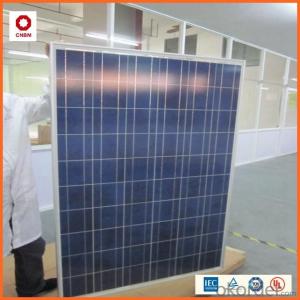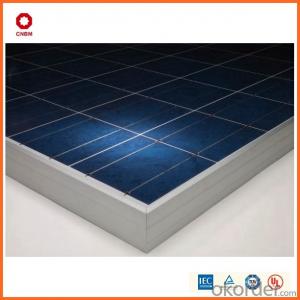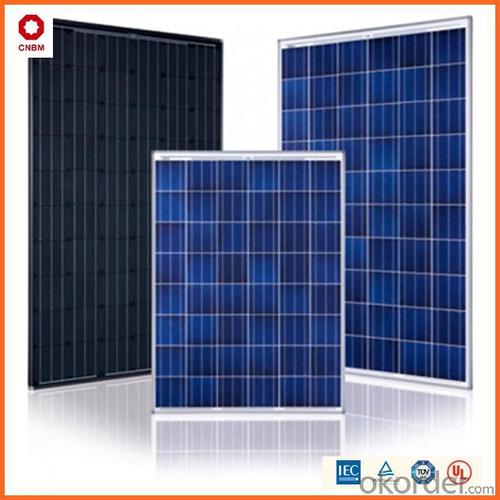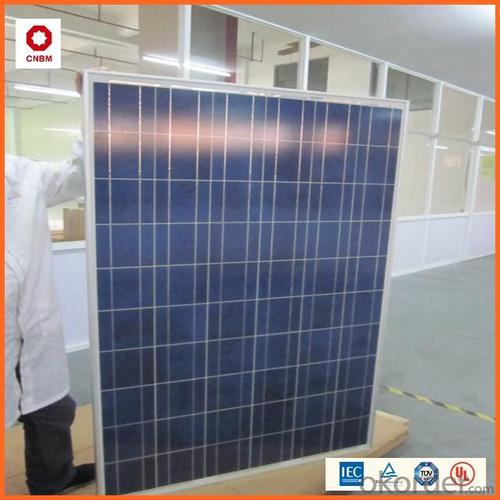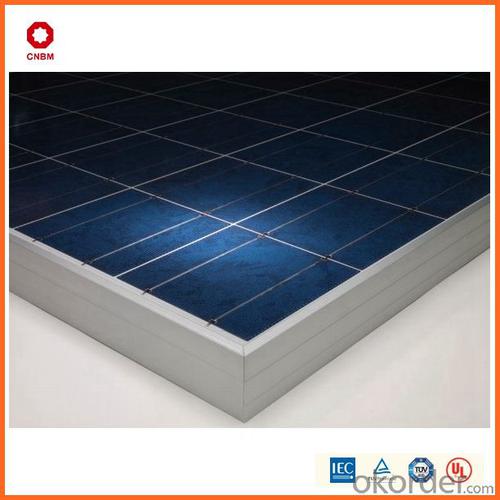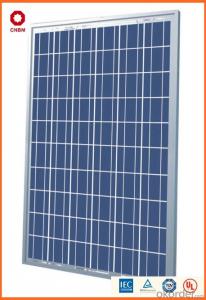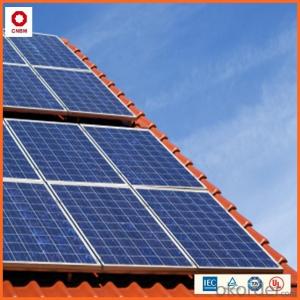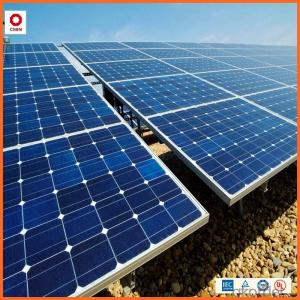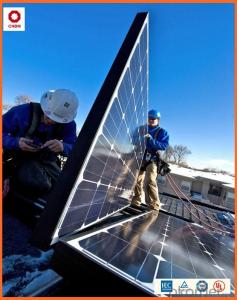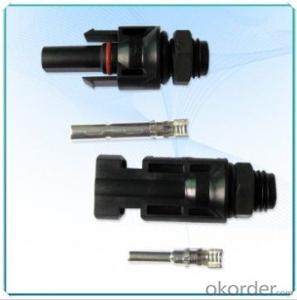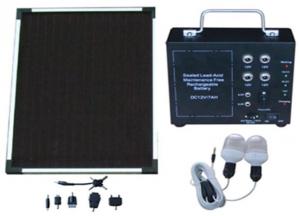El Sol Solar Energy Systems ☆☆☆Stock on Sale 260W Poly Solar Panel 0.45/W A Grade Good Solar Panel☆☆☆
- Loading Port:
- China main port
- Payment Terms:
- TT OR LC
- Min Order Qty:
- 1 watt
- Supply Capability:
- 10000000 watt/month
OKorder Service Pledge
OKorder Financial Service
You Might Also Like
Product Description:
Hot Sale !!! Quality and Safety of 245w-320w Poly Solar Panel
1. Rigorous quality control meets the highest international standards.
2. High-transmissivity low-iron tempered glass, strong aluminium frame.
3. Using UV-resistant silicon.
4. IS09001/14001/CE/TUV/UL
Warranties of 245w-320w Poly Solar Panel
1. 10 years limited product warranty
2. 15 years at 90% of the minimal rated power output
3. 25 years at 80% of the minimal rated power output
Technical date of 245w-320w Poly Solar Panel
ITEM NO.: | Mono 125*125 cell ,36pcs . Power range from 80Wp-100Wp | ||||||||
Maximum Power(W) | 80 | 85 | 90 | 95 | 100 | ||||
Optimum Power Voltage(Vmp) | 17.81 | 17.89 | 17.94 | 17.99 | 18.06 | ||||
Optimum Operatige Current(Imp) | 4.78 | 4.91 | 5.12 | 5.35 | 5.59 | ||||
Open Circuit Voltage(Voc) | 21.98 | 22.05 | 22.14 | 22.28 | 22.45 | ||||
Short Circuit Current(Isc) | 4.95 | 5.15 | 5.36 | 5.65 | 5.84 | ||||
Solar Cell: | 125*125 Mono | ||||||||
Number of Cell(pcs) | 4*9 | ||||||||
Brand Name of Solar Cells | JA Cell, Bluesun Cell | ||||||||
Size of Module(mm) | 1580*808*35 | ||||||||
Caple & Connector Type | Pass the TUV Certificate | ||||||||
Frame(Material Corners,etc.) | Aluminium-alloy | ||||||||
Backing (Brand Type) | TPT | ||||||||
Cell Efficiency for 100W(%) | 15.8% | ||||||||
Weight Per Piece(KG) | 12.0KG | ||||||||
FF (%) | 70-76% | ||||||||
Junction Box Type | Pass the TUV Certificate | ||||||||
Tolerance Wattage(e.g.+/-5%) | ±3%, or 0-3% | ||||||||
Front Glass Thikness(mm) | 3.2 | ||||||||
Temperature Coefficients of Isc(%) | +0.04 | ||||||||
Temperature Coefficients of Voc(%) | -0.38 | ||||||||
Temperature Coefficients of Pm(%) | -0.47 | ||||||||
Temperature Coefficients of Im(%) | +0.04 | ||||||||
Temperature Coefficients of Vm(%) | -0.38 | ||||||||
Temperature Range | -40°C to +85°C | ||||||||
Surface Maximum Load Capacity | 2400Pa | ||||||||
Allowable Hail Load | 23m/s ,7.53g | ||||||||
Bypass Diode Rating(A) | 12 | ||||||||
Warranty | 90% of 10 years,80% of 25 years. | ||||||||
Standard Test Conditions | AM1.5 1000W/ 25 +/-2°C | ||||||||
Packing | carton or pallet | ||||||||
1*20' | 25 Pallets / 450pcs | ||||||||
1*40'STD | 25 Pallets / 100pcs | ||||||||
Features of our products:
• High conversion efficiency mono/poly-crystalline amorphous silicon solar cells
• Modules incorporate high performance bypass diodes to minimize the power drop caused by shading
• High transmittance, low-iron tempered glass
• High performance EVA encapsulant to prevent destroying and water.
• AI frame: without screw, corner connection. 8 holes on the frame can be installed easily
• Good performance of preventing from atrocious weather such as wind and hails
• Certifications: CE IEC TUV VDE UL, Class I
• 10 years 90% power output warranty
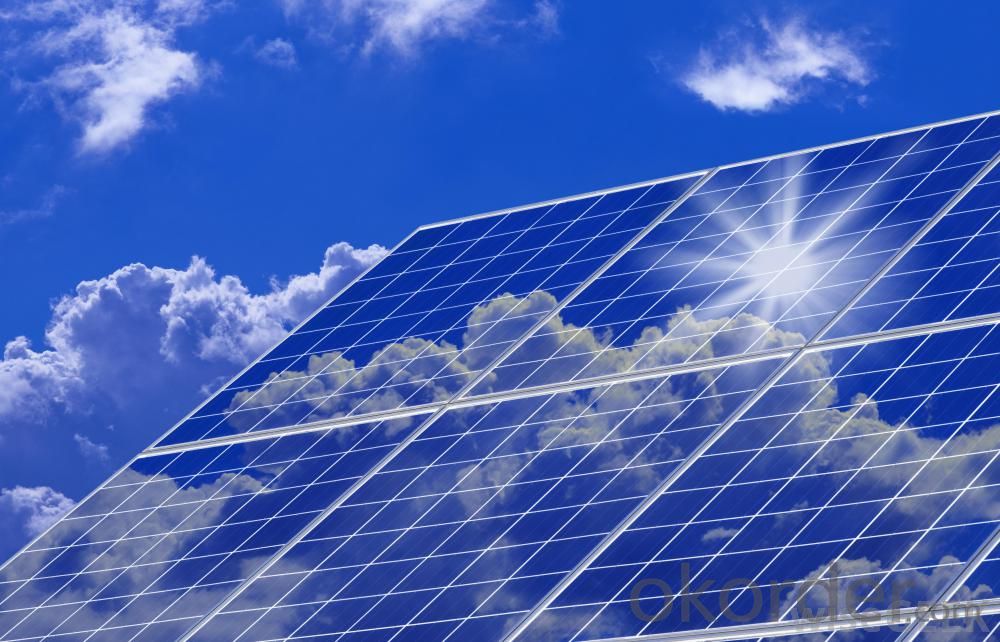
Shipping of 245w-320w Poly Solar Panel
By Sea | Delivery from Shanghai or Ningbo seaport |
By Air | Departure from Shanghai Pudong Airport |
By Express | Post by DHL, EMS, UPS, TNT. |
- Q: Can solar energy systems be used in areas with high wind conditions?
- Yes, solar energy systems can be used in areas with high wind conditions. While wind turbines are typically used to harness wind energy, solar panels can still be installed and function effectively in such areas. The performance of solar panels may be slightly impacted by the presence of wind, but with proper design and installation, they can still generate significant amounts of clean energy.
- Q: Can solar energy systems be used in powering hotels or resorts?
- Certainly, hotels and resorts can make use of solar energy systems to power their facilities. Solar power is a renewable and clean energy source that can effectively meet the energy requirements of these establishments. Hotels and resorts typically consume a substantial amount of energy for various purposes, such as lighting, heating, cooling, and running electrical appliances and equipment. To harness the abundant sunlight, hotels and resorts can opt to install solar panels on their rooftops or in open areas. This allows them to convert sunlight into electricity, which can then be used to power the entire facility. By doing so, these establishments reduce their dependence on traditional energy sources, resulting in a decreased carbon footprint. In addition to its environmental advantages, solar energy systems can offer financial benefits to hotels and resorts. By generating their own electricity, these establishments can significantly lower or eliminate their utility bills, leading to substantial cost savings in the long run. Furthermore, some countries provide incentives, grants, or tax credits for the implementation of solar power systems, making such installations economically viable. Moreover, the availability of solar energy is not limited to sunny days. With advancements in technology, solar panels can still generate electricity even during cloudy or overcast conditions. Furthermore, any excess energy produced during peak sunlight hours can be stored in batteries for later use, ensuring a steady power supply throughout the day and night. By adopting solar energy systems, hotels and resorts can demonstrate their commitment to sustainability and environmental responsibility. This can serve as a valuable marketing tool, attracting environmentally conscious guests who prefer eco-friendly accommodations. It also aligns with the growing trend of sustainable tourism, enhancing the reputation and competitiveness of these establishments in the industry. Overall, solar energy systems are a practical and efficient solution for powering hotels and resorts. They offer a multitude of benefits, including reduced utility costs, environmental sustainability, and increased market appeal. As technology continues to advance and become more affordable, more hotels and resorts are embracing solar power as a reliable and clean energy source.
- Q: How does the cost of solar energy compare to other energy sources?
- Over the past few years, solar energy has become increasingly cost competitive with other forms of energy. In the beginning, solar panels were more expensive due to high installation costs and limited efficiency compared to fossil fuels. However, advancements in technology, economies of scale, and supportive government policies have significantly reduced the cost of solar energy. Currently, solar energy is rapidly becoming more affordable and competitive. In many areas, it is already cheaper than coal and natural gas, which used to be the most cost-effective energy sources. This trend is expected to continue as solar technology improves and becomes more efficient. One of the main reasons for the decrease in solar energy costs is the falling prices of solar panels. Over time, the prices of photovoltaic (PV) modules, the key component of solar panels, have significantly dropped. Additionally, the manufacturing process has become more streamlined and efficient, resulting in cost savings. Moreover, the operational costs of solar energy are relatively low because sunlight, the primary fuel source, is abundant and free. Compared to fossil fuel-based power plants, solar energy systems require less maintenance and have a longer lifespan, leading to lower operating costs in the long run. Government incentives and policies have also played a crucial role in reducing the cost of solar energy. Many countries and regions offer financial incentives, tax credits, grants, and subsidies to encourage the use of solar energy. These initiatives make solar installations more affordable for consumers and incentivize investment in solar technology, driving economies of scale and further reducing costs. In conclusion, the cost of solar energy has become highly competitive with other energy sources due to technological advancements, economies of scale, and supportive government policies. As solar energy becomes more affordable, it is expected to play a significant role in the global energy transition, offering a clean, sustainable, and cost-effective alternative to traditional energy sources.
- Q: Can solar energy systems be installed on sloped roofs?
- Yes, solar energy systems can be installed on sloped roofs. In fact, sloped roofs are quite common for solar panel installations. The angle and orientation of the roof are important factors in determining the efficiency of the solar energy system. Ideally, a sloped roof with a south-facing orientation will maximize the amount of sunlight exposure throughout the day. However, solar panels can still be installed on roofs with different orientations or slopes, albeit with some adjustments in panel placement and tilt angles. It is important to consult with a professional solar installer who can assess the specific roof conditions and design a customized solar energy system that works best for the slope and orientation of the roof.
- Q: Can solar energy systems be used to power an entire home?
- Yes, solar energy systems can be used to power an entire home. With the right setup and sufficient solar panels, a solar energy system can generate enough electricity to meet the energy needs of a household. This can include powering appliances, lighting, heating, cooling, and other electrical devices in a home.
- Q: Can solar energy systems be used for powering recycling facilities?
- Yes, solar energy systems can definitely be used for powering recycling facilities. Solar energy is a renewable and clean source of power that can be harnessed using photovoltaic (PV) panels or solar thermal systems. These systems convert sunlight into electricity or heat, which can then be utilized to power various operations within a recycling facility. The electricity generated through solar panels can be used to power the machinery and equipment required for recycling processes, such as conveyors, sorting machines, crushers, and compactors. Additionally, solar energy can also be used to power lighting systems, ventilation, and heating/cooling systems, ensuring a sustainable and efficient operation of the facility. Using solar energy for powering recycling facilities offers several advantages. Firstly, it reduces reliance on traditional fossil fuel-based electricity, thereby decreasing carbon emissions and mitigating environmental impact. Secondly, solar energy systems provide a stable and predictable source of power, reducing the vulnerability to power outages or price fluctuations. Furthermore, solar power can help recycling facilities save on energy costs in the long run, as the initial investment in solar panels can be offset by the reduced electricity bills over time. In conclusion, solar energy systems are a viable and environmentally-friendly option for powering recycling facilities. By harnessing the power of the sun, these facilities can operate sustainably, reduce their carbon footprint, and contribute towards a cleaner and greener future.
- Q: Can solar energy systems be used for lighting outdoor spaces?
- Yes, solar energy systems can be used for lighting outdoor spaces. Solar lighting systems typically consist of solar panels, batteries, and LED lights. The solar panels collect sunlight and convert it into electricity, which is stored in the batteries. The LED lights are then powered by the stored electricity and provide illumination for outdoor spaces such as gardens, pathways, patios, or parks. Solar-powered outdoor lighting systems have several advantages. First, they are environmentally friendly as they do not produce any greenhouse gas emissions during operation. Additionally, they do not require any external power source, making them independent of the electrical grid. This makes them particularly suitable for remote or off-grid locations where connecting to the grid may be difficult or costly. Solar outdoor lighting systems are also cost-effective in the long run. While the initial installation cost may be higher compared to traditional lighting systems, there are no monthly electricity bills associated with solar lighting. Furthermore, solar lighting systems have low maintenance requirements, as the solar panels and batteries are designed to withstand various weather conditions. Another benefit of solar lighting systems is their flexibility and ease of installation. Since they do not require underground wiring or electrical connections, they can be easily installed in any outdoor space. This makes them ideal for temporary or seasonal lighting needs, as they can be easily moved or repositioned. In conclusion, solar energy systems can indeed be used for lighting outdoor spaces. They offer numerous benefits such as environmental sustainability, cost-effectiveness, low maintenance, and easy installation. Solar lighting systems are a practical and reliable solution for illuminating outdoor areas while minimizing energy consumption and reducing carbon footprint.
- Q: Are there any limitations to using solar energy for powering vehicles?
- Yes, there are some limitations to using solar energy for powering vehicles. The main limitation is the limited amount of energy that can be harvested from the sun, especially when compared to the energy density of conventional fossil fuels. Additionally, solar panels require a large surface area for installation, which could be a challenge for vehicles with limited space. Moreover, solar energy is intermittent, meaning it is not available during the night or in cloudy weather, which might affect the reliability and range of solar-powered vehicles. Finally, the cost of solar panels and their relatively low efficiency in converting sunlight to electricity also pose challenges to widespread adoption. Nonetheless, advancements in technology and the development of energy storage solutions are helping to overcome some of these limitations and make solar-powered vehicles more viable.
- Q: What is the role of solar energy systems in promoting social equity?
- Solar energy systems play a crucial role in promoting social equity by providing access to clean and affordable energy for all. These systems reduce the reliance on fossil fuels, which disproportionately affect low-income communities. By enabling households to generate their own renewable energy, solar power helps reduce energy costs and creates opportunities for economic empowerment. Additionally, solar energy projects can be implemented in marginalized communities, creating local job opportunities and fostering community development. Overall, solar energy systems contribute to a more equitable society by addressing energy poverty and reducing environmental injustices.
- Q: What is the impact of shading on the performance of solar panels?
- Shading has a significant impact on the performance of solar panels. When any part of a solar panel is shaded, it reduces the amount of sunlight that reaches the cells, resulting in a decrease in energy production. This is because solar panels operate by converting sunlight into direct current (DC) electricity through the photovoltaic effect. When a solar panel is partially shaded, it creates what is known as a "hotspot effect." This occurs when shaded cells within a panel become a high-resistance pathway for the flow of electricity, leading to a localized increase in temperature. This increased heat can degrade the performance of the entire panel and reduce its overall efficiency. Furthermore, shading also affects the panel's overall voltage and current output. Solar panels are typically connected in series to increase the output voltage. However, if even a single panel is shaded, it can significantly reduce the performance of the entire series-connected string. This is because the shaded panel acts as a bottleneck, limiting the current flow through the entire string. To mitigate the impact of shading, various solutions can be implemented. One common approach is to use bypass diodes, which allow the current to flow around the shaded cells, preventing the hotspot effect. By incorporating bypass diodes, the energy loss due to shading can be minimized, ensuring that the rest of the solar panel continues to operate efficiently. Additionally, proper design and placement of solar panels can also help reduce the effects of shading. Installing solar panels in areas with minimal obstructions or shadows, such as rooftops or open fields, can maximize their exposure to sunlight. Regular maintenance, including trimming nearby trees or vegetation that may cast shadows, is also important to ensure optimal performance. In conclusion, shading has a significant impact on the performance of solar panels, leading to reduced energy production and efficiency. Understanding and addressing shading issues through the use of bypass diodes and careful installation can help maximize the output and effectiveness of solar panel systems.
Send your message to us
El Sol Solar Energy Systems ☆☆☆Stock on Sale 260W Poly Solar Panel 0.45/W A Grade Good Solar Panel☆☆☆
- Loading Port:
- China main port
- Payment Terms:
- TT OR LC
- Min Order Qty:
- 1 watt
- Supply Capability:
- 10000000 watt/month
OKorder Service Pledge
OKorder Financial Service
Similar products
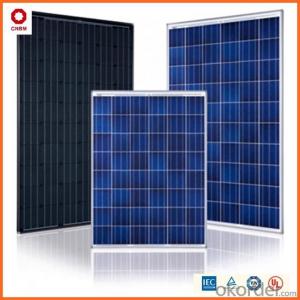
Solar Energy Systems Spain ☆☆☆stock on sale 255w poly solar panel 0.45/w!!!!☆☆☆ a grade good quality
Hot products
Hot Searches
Related keywords

